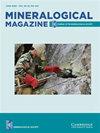Crystal structures of rhodium-containing erlichmanite–laurite solid solutions (Os1–x–yRuxRhyS2: x = 0.09–0.60, y = 0.07–0.10) with unique compositional dependence
IF 1.4
3区 地球科学
Q2 MINERALOGY
引用次数: 0
Abstract
Abstract Rh-rich and Ir-poor erlichmanite–laurite OsS2–RuS2 solid solutions have been discovered at placers in Haraigawa, Misato-machi, Kumamoto, Japan. Microprobe analysis was performed to identify solid solutions containing few sub-components other than Rh. Approximately 10 at.% Rh was found to be present in the solid-solution samples. Structural refinement was performed using four natural samples: Os0.32Ru0.61Rh0.07S2, Os0.49Ru0.43Rh0.08S2, Os0.58Ru0.33Rh0.08S2 and Os0.81Ru0.09Rh0.10S2. The unit-cell parameters for the solid solutions containing Rh from Haraigawa varied from 5.61826(6) to 5.63142(8) Å. The (Os, Ru, Rh)–S distances in the Os1–x–yRuxRhyS2 system were almost constant with a small variation of 0.001 Å. Conversely, the S–S distances varied significantly, with variations approaching 0.1 Å. Rh substitution of Os rather than Ru had a larger impact on the crystal structure. The atomic displacement ellipsoid of both cations and anions was almost spherical, and no elongation along the M–S and S–S bond directions was observed. The bulk Debye temperatures were estimated from the Debye–Waller factor for the sulfide site. The bulk Debye temperatures of pure OsS2 and RuS2 were 688 K and 661 K, respectively, which suggests that the melting point of erlichmanite is higher than that of laurite. The high Debye temperature of OsS2 is inconsistent with the crystallisation of laurite prior to erlichmanite from the primitive magma, which suggests that $f_{\rm S_2}$, rather than temperature, is the main cause of the known crystallisation order. The presence of several percent Rh has a significant effect on the thermal stability of OsS2 and lowers the melting point of the erlichmanite solid solution compared to that of the laurite solid solution.具有独特组成依赖性的含铑伊利石-月桂石固溶体(Os1–x–yRuxRhyS2:x=0.09–0.60,y=0.07–0.10)的晶体结构
摘要在日本熊本县三户町原井川砂矿中发现了富Rh和贫Ir的二辉橄榄岩-月桂石OsS2–RuS2固溶体。进行微探针分析以鉴定含有除Rh以外的少数亚组分的固溶体。发现在固体溶液样品中存在大约10at.%Rh。使用四种天然样品进行结构细化:Os0.32Ru0.61Rh0.07S2、Os0.49Ru0.43Rh0.08S2、Os0.58Ru0.33Rh0.08S2和Os0.81Ru0.09Rh0.10S2。来自Haraigawa的含有Rh的固溶体的晶胞参数在5.61826(6)至5.63142(8)Å之间变化。Os1–x–yRuxRhyS2系统中的(Os,Ru,Rh)–S距离几乎恒定,变化很小,为0.001Å。相反,S–S距离变化很大,变化接近0.1Å。Os而不是Ru的Rh取代对晶体结构的影响更大。阳离子和阴离子的原子位移椭球几乎是球形的,并且没有观察到沿M–S和S–S键方向的延伸。根据硫化物场地的德拜-沃勒系数估算出整体德拜温度。纯OsS2和RuS2的体相德拜温度分别为688 K和661 K,这表明伊利石的熔点高于月桂石。OsS2的高德拜温度与原始岩浆中的埃尔希曼岩之前的月桂岩结晶不一致,这表明$f_{\rmS_2}$而不是温度是已知结晶顺序的主要原因。几个百分比的Rh的存在对OsS2的热稳定性有显著影响,并且与月桂石固溶体的熔点相比,降低了伊利石固溶物的熔点。
本文章由计算机程序翻译,如有差异,请以英文原文为准。
求助全文
约1分钟内获得全文
求助全文
来源期刊

Mineralogical Magazine
地学-矿物学
CiteScore
4.00
自引率
25.90%
发文量
104
审稿时长
6-12 weeks
期刊介绍:
Mineralogical Magazine is an international journal of mineral sciences which covers the fields of mineralogy, crystallography, geochemistry, petrology, environmental geology and economic geology. The journal has been published continuously since the founding of the Mineralogical Society of Great Britain and Ireland in 1876 and is a leading journal in its field.
 求助内容:
求助内容: 应助结果提醒方式:
应助结果提醒方式:


